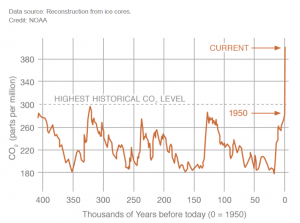With an iceberg nearly the size of Delaware calving off Antarctica the other day, it got me to thinking about climate change. OK, first it got me wondering just how big that is (twice as much water as Lake Erie, by the way). But then I thought: am I doing enough? What could we be doing differently? Where does technology fit in?

First, the big picture
Let me start by saying that scientists likely cannot directly attribute climate change to the specific calving event that produced the A68 (the boring name of said behemoth iceberg). What they can say, unequivocally, is that the earth’s natural systems are experiencing radical changes fueled by the increased greenhouse gas pollution we generate.
 The rate of change, too, is unprecedented in human history. In this graph from NOAA, you can see the CO2 levels during the last 400,000 years. There’s a steady, almost heartbeat rhythm to the up and down of atmospheric carbon dioxide. Until you get to the twentieth century, when we rocket past the historic high levels. Today, the atmospheric CO2 levels are about 406 parts per million – the highest ever recorded.
The rate of change, too, is unprecedented in human history. In this graph from NOAA, you can see the CO2 levels during the last 400,000 years. There’s a steady, almost heartbeat rhythm to the up and down of atmospheric carbon dioxide. Until you get to the twentieth century, when we rocket past the historic high levels. Today, the atmospheric CO2 levels are about 406 parts per million – the highest ever recorded.
Why does it matter? Because we are quickly heading to a 2-degrees Celsius increase in temperature if things don’t change – a threshold considered by most scientists to be a tipping point past which changes become essentially permanent. I am writing this with a child who is home with a fever of 100.4 (less than 2 degrees above normal) and it’s not lost on me what a mess he would be if his body ran a permanent 2-degree fever.
Scientists with the Intergovernmental Panel on Climate Change (IPCC) have calculated a global carbon budget that we would need to stick to if we’re going to stay under the magic 2 degrees Celsius of warming. A recent study showed that we’ve got about 600 gigatons left. That sounds like a lot, but if we want to stay under the magic 2 degrees Celsius, a lot has to change. Right now we emit approximately 41 gigatons per year, which gives us about 15 years. And let’s face it, the world would come to a crashing halt if we tried to suddenly go to zero.
So that’s the bad news.
The good news is we are making progress: emissions haven’t gone up the past few years (they haven’t gone down, either, but hey – progress). And, there are things we can all do to reduce our carbon footprint.
The things you can do may not be what you think
Do you recycle? Have you changed out those light bulbs for LEDs? A study that just came out in Environmental Research Letters, as reported by Science magazine, shows that four lifestyle choices have a major impact – and one dwarfs all the others: become a vegetarian, forego air travel, ditch your car and the biggest by far – have fewer children.

That’s not to say we should stop doing all the other things. First, every bit helps. Second, the personal changes will translate into greater overall awareness – which should help drive more change. It’s not that recycling doesn’t do enough: it’s that there’s so much to do.
While personal changes are important and we must continue to shift both our actions and our mindset, we need action from businesses and governments if we’re going to stay within our carbon budget.
Setting corporate greenhouse gas emissions goals
Right now, there is a lot of talk about setting “science-based goals” – those that follow the same reduction trajectory established by the IPCC. As Gareth Kane, chief blogger and director at Terra Infirma, has suggested, there are a number of benefits to these science-based goals: you’re committing to do your fair share, you can point to others using science-based targets, and there is some marketing cachet in using “science-based” almost as a seal of approval for your efforts.
However, Gareth – always the good skeptic – points out that there are some disadvantages, too. In particular, he calls out the emphasis on Scope 1 + 2 emissions (on-site generation and purchased power) while the requirements around Scope 3 are much looser. This, he suggests, reinforces the idea that Scope 1 + 2 are the main concern at the expense of looking across the value chain to understand where reductions could have the biggest impact.
Dell is a great example for this.
Among our Legacy of Good goals, we have one to reduce our absolute Scope 1 and Scope 2 (market-based) emissions by 40 percent from 2010, and we have another to source 50 percent of our total electricity from renewables (both purchased and on-site generation). This second one isn’t necessarily a greenhouse gas emissions goal, but it does directly affect our Scope 2.
These are not necessarily science-based targets. And I’m ok with that. If we meet our goal, Dell will avoid approximately 220,000 metric tons of CO2e.
Fun with numbers
We also have other goals that affect our Scope 3 emissions. For example, our goal to reduce the energy intensity across our product portfolio by 80 percent has already had a massive effect on our downstream emissions (Scope 3, use of sold products), which – in turn – reduces the Scope 2 emissions for our customers. Even just a 10 percent reduction of today’s Scope 3 (use of sold products) emissions would result in avoiding approximately 1,260,000 metric tons of CO2e.
You can see why focusing on Scope 3 emissions is so critical.
We also added this year a goal for many of our direct materials spend and key logistics suppliers to set their own specific greenhouse gas (GHG) emissions targets and to then report on their emissions inventory. As products become more energy efficient, more and more of their footprint is wrapped up in the manufacturing phase – and this goal will help us better manage and reduce those emissions.
Though these are the two largest, our Scope 3 (air and rail travel) is not insignificant. This last year it was almost 3x our Scope 1 emissions inventory. Technology can obviously make a difference when it comes to avoiding travel. Videoconferencing and cloud-based sharing of work products can all cut down on trips. And it’s not just these long-haul trips.
While we do not have a current measure of our Scope 3 (employee commute) emissions, we do have a Legacy of Good goal to drive 50 percent participation in flexible work programs. A study we did last spring showed that even after accounting for the rebound effect, the net mitigated emissions of telecommuting amount to about 1.15 metric tons per employee per year.
Even though this flexible work program isn’t specifically an emissions reduction effort, the impact is significant when measured across our employee base. But think about how much telecommuting can affect the emissions portfolio of the broader workforce: based on current commute data for the U.S., telecommuting is avoiding 30 million metric tons of CO2e. That number could be even greater with broader adoption.
So what can you do?
With that ever-shrinking carbon budget, we really do need an all-hands-on-deck approach to emissions reduction. Luckily, there are a number of ways you can help. I’ve already mentioned telecommuting and the use of various telecom solutions to replace some meetings. But how else can technology help?
One exciting place is in building controls. As the tools of the Internet of Things proliferate and we are better able to measure, fine-tune and automate things like HVAC, lighting, water use and more, we can have a significant effect on the amount of power our buildings use.
Switching to renewables is another obvious move. While it only ranked fourth on that list above, it’s can have a real effect at the scale of business.
And it’s not just wind turbines and solar panels. ELM Energy partnered with Dell to build an innovative microgrid control solution based on Dell Edge Gateway technology that helps integrate independent energy sources. By getting them all on one system, the solution helps make adding on-site generation much easier and affordable for their customers. As one example, one of their customers that relied on diesel generators to power a marina and 100 homes on a Caribbean island was able to cut emissions by 90 percent, get more value from the solar panels they’d installed, and ultimately replaced two of the generators with batteries and natural gas generators.
Harnessing the power of computing to measure and monitor systems, perform deep data analysis and identify the breakthroughs that will allow us to remake processes, eliminate inefficiencies and solve environmental challenges is another use of technology—and by making both the data and the computing power available via the cloud can open up opportunities for others who might not otherwise be able to work on such solutions.
While we are continuing to work toward an ever more energy-efficient portfolio (we’ve reduced energy intensity by 54 percent since 2011), there’s even more you can do to reduce technology’s footprint through virtualization. In fact, VMware’s services have helped reduce emissions by 340 million metric tons in the last 13 years.
Speaking truth to power
We are quickly approaching the Rubicon, if those carbon budget estimates are correct. While it’s easy to get caught up in the existential nature of the situation, I prefer to look at it a different way. Smart businesses are already seeing that setting emissions goals is more than just an environmental activity: it saves money, reduces risk and attracts (and keeps) top talent.
On July 28, An Inconvenient Sequel: Truth to Power will hit movie theaters. I am fortunate enough to be a part of the Climate Reality Leadership Corps. I’ve trained with Al Gore and understand the messages his follow-up movie will carry. There is no hiding from climate change and it’s clear that time is running out.
But it’s not too late and real solutions exist if we have the courage to demand them.
You can read more about Dell’s approach to climate change here.
This article shares one example of how Dell is committed to driving human progress by putting our technology and expertise to work where it can do the most good for people and the planet.
We invite you to explore our FY17 Annual update on our 2020 Legacy of Good Plan at legacyodgood.dell.com.